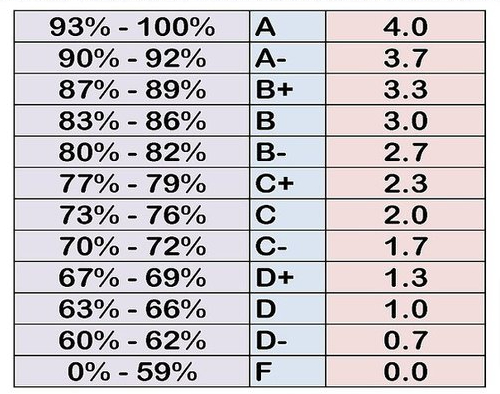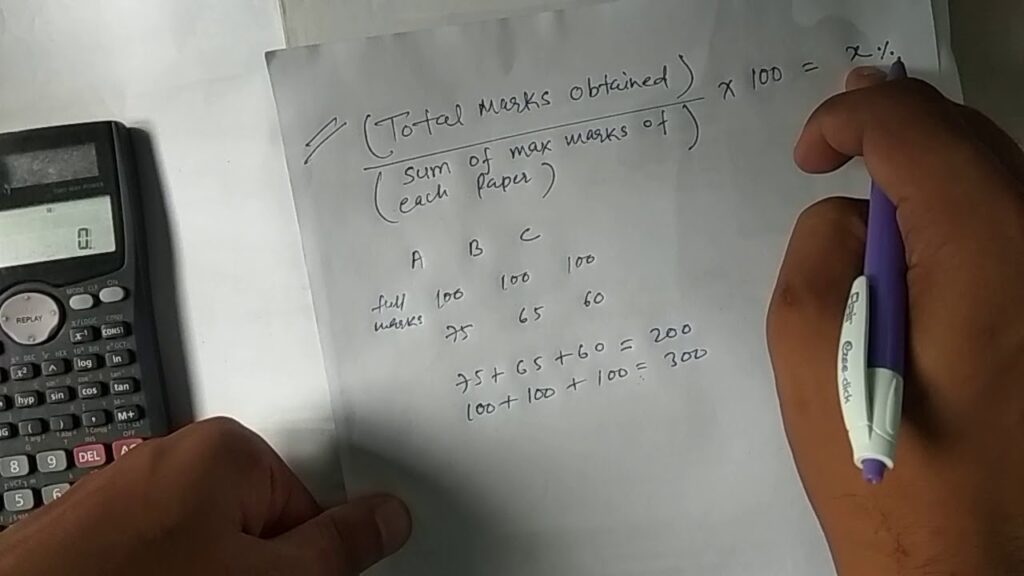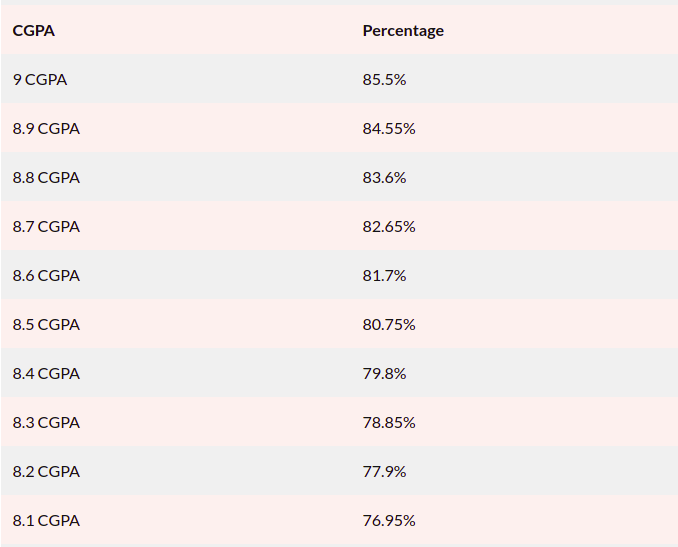Converting CGPA to a percentage is simple: just multiply your CGPA by 9.5. This method is effective because it aligns with how many grading systems assign similar weights to grade points and percentages.
For instance, a CGPA of 3.0 might equate to 75%, while a 4.0 CGPA could translate to 95%. This conversion is useful when explaining academic achievements to those unfamiliar with CGPA or when applying to programs using percentage-based evaluations.
It streamlines the process and ensures clarity in representing your academic performance across different contexts.
What is CGPA?
CGPA, or Cumulative Grade Point Average, is a way to measure a student’s overall academic performance. It’s calculated by averaging the grade points a student earns in each semester or term throughout their academic journey.
Usually, schools and colleges use a 10-point grading scale, where each grade corresponds to a specific grade point. CGPA takes into account all these grades over time, giving a comprehensive view of a student’s achievements.
So, it’s an important tool for schools and universities to evaluate students for scholarships, admissions, and job opportunities. In essence, CGPA provides a simple and effective way to understand how well a student is doing in their studies overall.
How to Convert CGPA to Percentage?

To convert CGPA to percentage, you can follow these steps:
Calculate CGPA:
- Add up the grade points for all subjects.
- Divide the total grade points by the number of subjects. This gives you your CGPA.
Multiply by 9.5
- Once you have your CGPA, multiply it by 9.5 to get the percentage equivalent.
So, the formula to convert CGPA to percentage is:
Percentage=CGPA×9.5
Percentage=CGPA×9.5
Let’s apply this formula to the examples given:
Example 1
Percentage=8×9.5=76%
Percentage=8×9.5=76%
Example 2
Percentage=8.9×9.5=84.55%
Percentage=8.9×9.5=84.55%
Therefore, the percentages for CGPA 8 and CGPA 8.9 are 76% and 84.55% respectively.
CGPA to Percentage Conversion Chart
| CGPA | Equivalent Percentage (%) | CGPA | Equivalent Percentage (%) |
| 10 | 95% | 6.9 | 65.55% |
| 9.9 | 94.05% | 6.8 | 64.6% |
| 9.8 | 93.1% | 6.7 | 63.65% |
| 9.7 | 92.15% | 6.6 | 62.7% |
| 9.6 | 91.2% | 6.5 | 61.75% |
| 9.5 | 90.25% | 6.4 | 60.8% |
| 9.4 | 89.3% | 6.3 | 59.85% |
| 9.3 | 88.36% | 6.2 | 58.9% |
| 9.2 | 87.4% | 6.1 | 57.95% |
| 9.1 | 86.45% | 6 | 57% |
| 9 | 85.5% | 5.9 | 56.05% |
| 8.9 | 84.55% | 5.8 | 55.1% |
| 8.8 | 83.6% | 5.7 | 54.15% |
| 8.7 | 82.65% | 5.6 | 53.2% |
| 8.6 | 81.7% | 5.5 | 52.25% |
| 8.5 | 80.75% | 5.4 | 51.3% |
| 8.4 | 79.8% | 5.3 | 50.35% |
| 8.3 | 78.85% | 5.2 | 49.4% |
| 8.2 | 77.9% | 5.1 | 48.45% |
| 8.1 | 76.95% | 5 | 47.5% |
| 8 | 76% | 4.9 | 46.56% |
| 7.9 | 75.05% | 4.8 | 45.6% |
| 7.8 | 74.1% | 4.7 | 44.65% |
| 7.7 | 73.15% | 4.6 | 43.7% |
| 7.6 | 72.2% | 4.5 | 42.75% |
| 7.5 | 71.25% | 4.4 | 41.8% |
| 7.4 | 70.3% | 4.3 | 40.85% |
| 7.3 | 69.35% | 4.2 | 39.9% |
| 7.2 | 68.4% | 4.1 | 38.95% |
| 7.1 | 67.45% | 4 | 38% |
| 7 | 66.5% |
Advantages or Disadvantages of the CGPA System

The CGPA (Cumulative Grade Point Average) system offers several advantages & disadvantages in educational evaluation:
Advantages
The CGPA system offers several advantages. Firstly, it provides a holistic representation of a student’s performance by amalgamating marks from various subjects or topics. This comprehensive approach allows for a better understanding of the student’s overall academic standing.
Additionally, CGPA enables students to identify their strengths and weaknesses based on individual grades. This empowers them to focus on areas that need improvement and excel in their studies.
Disadvantages
Despite its benefits, the CGPA system has notable drawbacks. Firstly, it can lessen competition among students by shifting focus from striving for high grades to achieving a passable cumulative score. Consequently, some students may become demotivated.
Moreover, the system may be perceived as unfair since students with vastly different individual scores can end up with the same CGPA. This disparity can lead to a sense of injustice among students who feel their efforts are not accurately reflected in their grades.
Furthermore, the CGPA system may overstate the academic achievements of some students by rewarding a higher percentage than their actual marks suggest. Additionally, the wide gaps between grades can result in inaccuracies, impacting the overall assessment of student performance.
Why Convert CGPA to Percentage?
Converting CGPA to a percentage is crucial for several reasons. Firstly, it allows for a more standardized comparison of academic performance, particularly across different educational systems or institutions.
This conversion ensures that students can effectively communicate their achievements in a format that is universally understood. It facilitates applications for employment, higher education, scholarships, and grants.
Moreover, converting CGPA to a percentage provides a clearer assessment of individual academic standing and enables students to set meaningful goals for improvement.
Ultimately, this conversion process plays a vital role in ensuring fairness, consistency, and compatibility with diverse academic and professional requirements.
FAQ’s
How do you convert a 4.0 CGPA to a percentage?
To convert a CGPA of 4.0 to a percentage, simply refer to the conversion table, where a 4.0 CGPA corresponds to 38%. This means that a CGPA of 4.0 translates to a percentage score of 38%.
How do you convert an 8.8 CGPA to a percentage?
To convert a CGPA of 8.8 to a percentage, follow these steps: Calculate the CGPA of all semesters, sum the calculated CGPAs, divide the summation of CGPAs by the total number of credit hours completed, and finally, multiply the CGPA by 9.5. This yields the equivalent percentage, where CGPA * 9.5 = Percentage.
Final Words
Converting CGPA to a percentage by multiplying it by 9.5 offers a straightforward method for communicating academic achievements. This conversion simplifies the process, making it easier to convey performance to those unfamiliar with CGPA and for applications requiring percentage-based evaluations.
By aligning with common grading practices, this approach ensures clarity and accuracy in representing academic success across various contexts. Whether sharing achievements or applying to programs, this conversion method is invaluable for effectively communicating academic accomplishments.
.
